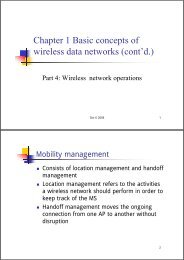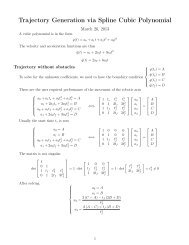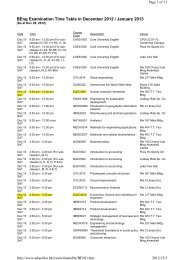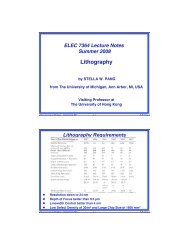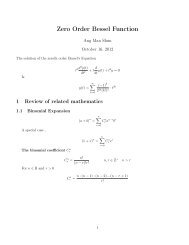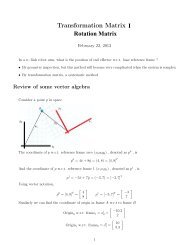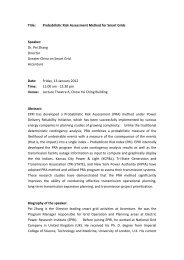A laboratory setup of a power transmission line system scaled model ...
A laboratory setup of a power transmission line system scaled model ...
A laboratory setup of a power transmission line system scaled model ...
You also want an ePaper? Increase the reach of your titles
YUMPU automatically turns print PDFs into web optimized ePapers that Google loves.
A <strong>laboratory</strong> <strong>setup</strong> <strong>of</strong> a <strong>power</strong> <strong>transmission</strong> <strong>line</strong> <strong>system</strong> <strong>scaled</strong> <strong>model</strong><br />
for testing and validation <strong>of</strong> sensor network applications<br />
Philip W. T. Pong, Carson K. S. Hung, Ronald C. L. Li, Simon C. F. Tam, W. K. Lee, Kenneth K. K.<br />
Wong, K. S. Lui<br />
Department <strong>of</strong> Electrical and Electronic Engineering, The University <strong>of</strong> Hong Kong, Pokfulam Road, Hong Kong<br />
Abstract—A <strong>laboratory</strong> <strong>setup</strong> <strong>of</strong> a <strong>scaled</strong> <strong>model</strong> <strong>of</strong> sensor<br />
network <strong>system</strong> and <strong>power</strong> <strong>transmission</strong> <strong>system</strong> has been<br />
developed at the Smart Grid and High Power System<br />
Laboratory <strong>of</strong> the University <strong>of</strong> Hong Kong. The sensor network<br />
consists <strong>of</strong> accelerometers, infrared sensor, strain gauge, and<br />
magnetic sensors, which provide accurate readings to monitor<br />
the status and position <strong>of</strong> the <strong>power</strong> <strong>transmission</strong> <strong>line</strong>, the tilt <strong>of</strong><br />
<strong>power</strong> tower, and <strong>power</strong> quality <strong>of</strong> the <strong>power</strong> <strong>transmission</strong><br />
<strong>system</strong>. A LabVIEW program was developed to provide the<br />
user interface for the monitoring <strong>system</strong> which can visualize the<br />
<strong>power</strong> <strong>transmission</strong> <strong>line</strong> infrastructure, process the sensors’<br />
data to display on the screen in real time, and synchronize GPS<br />
sensors data.<br />
Index Terms— Laboratory <strong>setup</strong>, Power <strong>transmission</strong> <strong>system</strong>,<br />
Sensor network <strong>system</strong>, LabVIEW<br />
I. INTRODUCTION<br />
Monitoring a <strong>power</strong> <strong>transmission</strong> <strong>line</strong> <strong>system</strong> with a more<br />
effective and accurate method in real time becomes more and<br />
more important in nowadays. The <strong>system</strong> covers in our entire<br />
city or country, and any problems may seriously affect our<br />
lives. For example, US and Canada occurred a very large<br />
scale <strong>power</strong> failure in 2003 which led to large economic loss<br />
and influenced the lives <strong>of</strong> people. The <strong>power</strong> <strong>transmission</strong><br />
<strong>line</strong> may also be a sabotage target. In Colombia, terrorists had<br />
attacked on the electricity infrastructure, and it is very<br />
difficult to avoid and predict which <strong>power</strong> node or<br />
<strong>transmission</strong> infrastructure is damaged. In the snowstorm in<br />
China in 2008, ice and snow aggregated on <strong>transmission</strong> <strong>line</strong>s<br />
and overloaded the <strong>power</strong> towers to led tower collapse.<br />
However, China did not have adequate technology to monitor<br />
the entire <strong>system</strong>, and they relied on manual field inspection<br />
<strong>of</strong> damaged cables. It is very time consuming and inefficient.<br />
Hence, an effective and accuracy sensor network for<br />
monitoring the <strong>power</strong> <strong>transmission</strong> <strong>line</strong> <strong>system</strong> in real time is<br />
necessary.<br />
Nowadays, Smart Grid System is starting to become<br />
popular in the world. A lot <strong>of</strong> countries’ government policy,<br />
such as Australia, Korea and China started to investigate the<br />
<strong>system</strong> feasibility in their country or planning development in<br />
the future. Moreover, in the Smart Grid System, renewable<br />
energy resources are <strong>of</strong>ten far away from the load centres.<br />
Long-distance <strong>power</strong> <strong>transmission</strong> <strong>line</strong>s are necessary to<br />
efficiently transmit the renewable energy to the load centers.<br />
Sensors are needed to monitor the effective operation <strong>of</strong> the<br />
<strong>transmission</strong> <strong>system</strong>. To save energy, reduce cost and<br />
increase reliability <strong>of</strong> <strong>power</strong> <strong>transmission</strong>, better sensors and<br />
communication are required.<br />
This paper presents an advancement <strong>of</strong> a sensor network to<br />
provide a more effective and accurate real time monitoring<br />
<strong>system</strong>, and <strong>scaled</strong> <strong>model</strong> <strong>of</strong> the <strong>power</strong> <strong>transmission</strong> <strong>line</strong><br />
<strong>system</strong> is presented in this paper. The monitoring <strong>system</strong><br />
included sensors which are needed to monitor the <strong>power</strong><br />
status to ensure constant <strong>power</strong> supply, assert for different<br />
<strong>power</strong> demand in different time period to reduce or increase<br />
the demand, and monitor the <strong>power</strong> tower and <strong>power</strong><br />
<strong>transmission</strong> <strong>line</strong> status. A LabVIEW program was developed<br />
for the monitoring <strong>system</strong> which can visualize the <strong>power</strong><br />
<strong>transmission</strong> <strong>line</strong> infrastructure, and process the sensors’ data<br />
to display on the screen for classify the problems in real time.<br />
In addition, the optical fiber is used for network<br />
communication, since they can support fast data <strong>transmission</strong><br />
and are robust to noise. GPS is used for sensor network time<br />
synchronization.<br />
The rest <strong>of</strong> this paper is organized as follows. In section II,<br />
the details <strong>of</strong> application for each sensor in the monitoring<br />
<strong>system</strong> are discussed. The whole <strong>laboratory</strong> <strong>setup</strong> including<br />
the <strong>scaled</strong> <strong>power</strong> <strong>transmission</strong> <strong>line</strong> <strong>model</strong>, sensor network<br />
with the monitoring <strong>system</strong>, and the LabVIEW interface are<br />
shown in section III. Section IV discusses the strengths and<br />
weaknesses <strong>of</strong> the <strong>setup</strong>. Finally, the conclusion and future<br />
works are included the section V.<br />
II. APPLICATION OF THE SENSORS<br />
The purposes <strong>of</strong> developing the smart grid sensor network<br />
are (1) Real-time monitoring to enhance situational<br />
awareness, and keep check the <strong>power</strong> status to ensure<br />
constant <strong>power</strong> supply due to merging <strong>of</strong> the non-renewable<br />
energy and renewable energy and <strong>power</strong> failure.<br />
Furthermore, the network monitors the different <strong>power</strong><br />
demands due to different usage in different time period. (2)<br />
Anticipation to check for potential problems, assess trouble<br />
signs and estimate possible disturbances. (3) Locate the<br />
accurate position <strong>of</strong> abnormal <strong>power</strong> towers or <strong>transmission</strong><br />
<strong>line</strong> in a large <strong>power</strong> supply network. (4) Self-healing based<br />
on sensor data and identifies corrective actions.<br />
The sensor network includes different type <strong>of</strong> sensors to<br />
monitor the <strong>power</strong> <strong>transmission</strong> <strong>line</strong> <strong>system</strong>. Four type <strong>of</strong><br />
sensors are used in the monitoring <strong>system</strong> - Accelerometer,<br />
1
infrared sensor, Strain Gauge and Magnetic sensor- and their<br />
applications are presented as following.<br />
A. Accelerometer<br />
Accelerometer is applied to monitor the <strong>power</strong><br />
<strong>transmission</strong> <strong>line</strong> tilting and the <strong>power</strong> tower vibration and<br />
tilting. A common problem in the <strong>power</strong> <strong>transmission</strong> <strong>system</strong><br />
is the overhead <strong>transmission</strong> <strong>line</strong> sagging problem. When too<br />
much current is flowing, the cable heats up and sags. The<br />
cable may touch trees and lead to short circuit. Hence, the<br />
accelerometer can keep check <strong>of</strong> the tilting angle <strong>of</strong> the <strong>power</strong><br />
<strong>transmission</strong> <strong>line</strong> to avoid this problem. Moreover, the <strong>power</strong><br />
tower may not bear the weight <strong>of</strong> the <strong>transmission</strong> <strong>line</strong> if the<br />
ice or snow placed on the <strong>transmission</strong> <strong>line</strong>, and the <strong>power</strong><br />
tower may be deformed due the weight <strong>of</strong> the <strong>transmission</strong><br />
<strong>line</strong>, so the accelerometer is needed to monitor the <strong>power</strong><br />
tower vibration and tilting.<br />
Fig. 1 Accelerometer<br />
B. Infra red sensor<br />
The temperature is monitored by the infrared sensor, since<br />
the temperature <strong>of</strong> the <strong>transmission</strong> <strong>line</strong> is increased when the<br />
current flow is increased, which increases the length <strong>of</strong> the<br />
<strong>transmission</strong> <strong>line</strong>. The extension can be calculated by the<br />
temperature variation and the characteristic <strong>of</strong> the material, so<br />
the monitoring <strong>system</strong> can output the warning if the<br />
<strong>transmission</strong> <strong>line</strong> length exceeds the length limit. Hence, the<br />
problem can be avoided. If the temperature is too high, it may<br />
damage the <strong>transmission</strong> <strong>line</strong>, so the operator can reduce the<br />
load <strong>of</strong> that <strong>transmission</strong> <strong>line</strong>, and use the others for the<br />
<strong>transmission</strong>. The infrared sensor is used to detect the<br />
temperature, and has the advantage <strong>of</strong> fast response and high<br />
accuracy without physical contact. It is used to monitor<br />
overheat conditions.<br />
C. Strain Gauge<br />
The strain gauge is applied to keep check <strong>of</strong> the length <strong>of</strong><br />
the <strong>transmission</strong> <strong>line</strong>. For the overhead <strong>transmission</strong> <strong>line</strong><br />
sagging problem, accurate length with the tilting angle is<br />
necessary to avoid this problem. The strain gauge can output<br />
the accurate length extension calculated from the weight or<br />
force applied to the <strong>transmission</strong> <strong>line</strong>.<br />
Fig. 3 Strain Gauge<br />
D. Magnetic sensor<br />
The magnetic sensor is a very important sensor in the<br />
monitoring <strong>system</strong>, since it monitors a few parameters at the<br />
same time, including the <strong>power</strong> <strong>transmission</strong> <strong>line</strong> position and<br />
tilting, current flow, magnitude and frequency. A common<br />
problem in the <strong>power</strong> <strong>transmission</strong> <strong>system</strong> is the overhead<br />
cable gallop problem. In adverse weather conditions with<br />
strong wind, the cable swings which can lead to contact with<br />
another phase <strong>line</strong> or mechanical failure. Therefore, the<br />
position <strong>of</strong> the <strong>transmission</strong> <strong>line</strong> is needed to be monitored.<br />
Based on the characteristic <strong>of</strong> the <strong>transmission</strong> <strong>line</strong>, the<br />
current passing through the <strong>transmission</strong> <strong>line</strong> will generate a<br />
magnetic field, and the field is detected by the sensor, and the<br />
readings are passed back to the <strong>system</strong> for analysis. This data<br />
can be used to find out the <strong>power</strong> <strong>transmission</strong> <strong>line</strong> position<br />
and tilting, current flow, magnitude and frequency.<br />
Fig. 4 Magnetic sensor<br />
III. LABORATORY SETUP<br />
Fig. 2 Infra red sensor<br />
The mission <strong>of</strong> the smart grid sensor network is monitoring<br />
the operation <strong>of</strong> the <strong>power</strong> delivery network <strong>system</strong>. For each<br />
<strong>power</strong> tower or <strong>power</strong> station, the sensors are installed, which<br />
connects to a Collect Data Station, for collect the data <strong>of</strong> the<br />
status <strong>of</strong> <strong>power</strong> tower and <strong>power</strong> <strong>transmission</strong> <strong>line</strong>, and<br />
sending back the monitoring data to Power System Control<br />
Centre, which to be a Monitoring Station, for monitoring a<br />
number <strong>of</strong> <strong>power</strong> tower or <strong>power</strong> station. Due to low cost and<br />
2
easy installation <strong>of</strong> the sensors, enormous number <strong>of</strong> sensors<br />
can be deployed over a huge geographic area. Fig. 5 shows<br />
the Power System Control Centre monitoring the status <strong>of</strong><br />
<strong>power</strong> tower and <strong>power</strong> <strong>transmission</strong> <strong>line</strong>.<br />
<strong>power</strong> delivery <strong>system</strong>. Four accelerometers are <strong>setup</strong> in the<br />
<strong>model</strong>, two are installed vertically for each <strong>power</strong> tower<br />
vibration and tilting, and the other two are <strong>setup</strong> horizontally<br />
on the cable near to the <strong>power</strong> tower for monitoring the tilting<br />
angle <strong>of</strong> the cable. Two strain gauges are also <strong>setup</strong> on the<br />
cable in the same way as the accelerometers to keep check <strong>of</strong><br />
the extension. The infrared sensor targets on the cable near to<br />
the tower, since the cable stays at a more stable position for<br />
monitoring the temperature. Two magnetic sensors are placed<br />
at the left and right <strong>of</strong> the cable for detecting the magnetic<br />
field to calculate the accurate position <strong>of</strong> the cable, and<br />
monitoring the current status, such as, flow, magnitude and<br />
frequency. The data <strong>of</strong> the sensors send to the DAQ card<br />
(analog-digital interface card) for data conversion, and then<br />
send to Collect Data Station for data processing.<br />
Fig. 5 Sensor network with Power System Control Centre<br />
For the sensor network <strong>system</strong>, the sensors receive the<br />
monitoring data. The data is passed through the analog-digital<br />
interface card for data processing in the Collect Data Station,<br />
and the data will be converting to optical signal. After the data<br />
processing, the status <strong>of</strong> <strong>power</strong> tower and <strong>power</strong> <strong>transmission</strong><br />
<strong>line</strong> are sent back to the Monitoring Station by the optical<br />
fiber interface, and the networking is from a Hybrid<br />
Topology. Fig.6 is shown the data flow from the sensors to<br />
optical fiber.<br />
Fig. 7 Schematic diagram <strong>of</strong> the sensor network<br />
Fig. 8 shows the <strong>laboratory</strong> <strong>setup</strong> dimension. The <strong>power</strong><br />
<strong>transmission</strong> <strong>line</strong> is 3m in length. Strain gauge is located 0.1m<br />
from to the <strong>power</strong> tower on the <strong>power</strong> <strong>transmission</strong> <strong>line</strong>, and<br />
the accelerometer, on the <strong>power</strong> <strong>transmission</strong> <strong>line</strong>, is 0.2m<br />
from to the <strong>power</strong> tower. The accelerometer is 0.25m from<br />
the ground. Infrared sensor is 0.15m horizontally from the<br />
<strong>power</strong> <strong>line</strong>. The magnetic sensors under the <strong>power</strong><br />
<strong>transmission</strong> <strong>line</strong> are 0.35m away from the <strong>line</strong>, and the<br />
distance between the sensors is 0.6m, and 1.5m to the <strong>power</strong><br />
tower.<br />
Fig. 6 Sensors’ data flow<br />
The <strong>laboratory</strong> <strong>setup</strong> is developed at the Smart Grid and<br />
High Power System Laboratory at the University <strong>of</strong> Hong<br />
Kong. The whole <strong>setup</strong> includes three parts, (1) Power Tower<br />
and Power Transmission Line, (2) Sensor Network with the<br />
Collect Data Station, and (3) User Interface by LabVIEW<br />
with Monitoring Station. The whole <strong>system</strong> is a <strong>scaled</strong> down<br />
<strong>model</strong>. Fig. 7 illustrates the schematic diagram <strong>of</strong> the sensor<br />
network with the <strong>power</strong> tower and <strong>power</strong> <strong>transmission</strong> <strong>line</strong>.<br />
In the <strong>model</strong>, two <strong>power</strong> towers and a <strong>power</strong> cable to form a<br />
Fig. 8 Laboratory <strong>setup</strong> dimension<br />
3
Fig. 9 illustrates the physical layout <strong>of</strong> the <strong>model</strong> <strong>of</strong> the<br />
schematic diagram <strong>of</strong> the sensor network with the <strong>power</strong><br />
tower and <strong>power</strong> <strong>transmission</strong> <strong>line</strong>.<br />
Fig. 9 Setup in the <strong>laboratory</strong><br />
Fig. 11 Accelerometer in the <strong>setup</strong><br />
A current generator is supplies a constant AC current with<br />
a sine wave form, and the current range is within 10 to 2000A<br />
with a small voltage.<br />
Fig. 12 Accelerometer sensing axis<br />
For the strain gauge, four oVishay Micro-Measurements<br />
125AC strain gauges form a full-bridge circuit (Wheatstone<br />
bridge), which can provide all-round and accurate length<br />
extension when placed on the <strong>power</strong> <strong>transmission</strong> <strong>line</strong>. Eight<br />
strain gauges were installed in the <strong>model</strong>.<br />
Fig. 10 Power supply for the <strong>transmission</strong> <strong>line</strong><br />
The accelerometer is Freescale Semiconductor three axis<br />
micro-machined surface mount accelerometer (MMA7360L).<br />
It has x, y and z axis motion detection, so it works like as a<br />
motion sensor to monitor the motion and the tilting angle <strong>of</strong><br />
the <strong>power</strong> <strong>transmission</strong> <strong>line</strong>. Moreover, it has free fall<br />
detection, which is useful for detection <strong>of</strong> damaged or<br />
destroyed <strong>power</strong> <strong>transmission</strong> <strong>line</strong>s or <strong>power</strong> towers. It can<br />
detect the tilting angle within 90 degrees, and the sensitivity<br />
is +/-1.5g or +/-6g.<br />
Fig. 13 Strain gauge in the <strong>setup</strong><br />
4
The infrared sensor is the Micro-Epsilon thermometer<br />
CTlaser (CTL-SF75-C2) and is used to monitor the<br />
temperature <strong>of</strong> the <strong>power</strong> <strong>transmission</strong> <strong>line</strong>. The detector<br />
temperature range is within -40°C to 975°C, and it has a fast<br />
response time <strong>of</strong> 120ms. The infrared sensors should not be<br />
directed upwards while targeting the <strong>transmission</strong> <strong>line</strong>,<br />
because sunlight may affect detection, so the targeting should<br />
be done in a horizontal or downwards orientation.<br />
Fig. 17 Magnetic sensors in the <strong>setup</strong><br />
Fig. 14 Intra red sensor<br />
The monitoring data from sensors is passed to the DAQ<br />
card (analog-digital interface card), which is the National<br />
Instruments NI USB 6211 M series multifunction DAQ card.<br />
The DAQ card has 16 analog input pins with +/-10V voltage<br />
range (16bits) which are enough for receiving the data from<br />
the sensors. The card accepts 250kS/s, a high rate for data<br />
sampling. The USB interface is convenient to connect to the<br />
Collect Data Station for data processing.<br />
Fig. 18 DAQ card<br />
Fig. 15 Intra red sensor head in the <strong>setup</strong><br />
For the magnetic sensor, the Honeywell HMC2003<br />
three-axis magnetic sensor hybrid is selected for this<br />
<strong>laboratory</strong> <strong>setup</strong>. It can monitor x, y and z axis magnetic field<br />
at the same time, and it has a <strong>line</strong>ar detection dynamic range<br />
<strong>of</strong> +/-2gauss with high resolution 40 micro-gauss. Moreover,<br />
an <strong>of</strong>fset can be set to reduce the external magnetic field. The<br />
sensors are placed under the <strong>power</strong> <strong>transmission</strong> <strong>line</strong>, in the<br />
bottom left and bottom right positions.<br />
The Collect Data Station converts the monitoring data to<br />
optical signal, which passes through the optical fibre to the<br />
Monitoring Station for analysis and display in the LabVIEW<br />
user interface; therefore, the Collect Data Station and<br />
Monitoring Station also have to include the optical interface<br />
card. For this card, OLYCOM OM910-FE/S25 is selected for<br />
the <strong>setup</strong>, due to its capability to operate at 100Mbps and to<br />
provide a network throughput <strong>of</strong> 200Mbps in full-duplex<br />
mode, and fast response <strong>of</strong> optical fiber reconnection.<br />
Moreover, it can operate over a long distance. The FC/PC<br />
connector, single-mode optical fiber is connected between the<br />
Collect Data Station and Monitoring Station.<br />
Fig. 16 Magnetic sensor<br />
Fig. 19 Optical interface card<br />
5
The Monitoring Station is a LabVIEW User Interface, base<br />
on the operation <strong>of</strong> the sensor network <strong>system</strong>, all the sensors<br />
also have their duty, and their data can provide the numeral<br />
and visual result on the interface.<br />
Fig. 20 illustrates the LabVIEW User Interface. The top<br />
left diagram is the position <strong>of</strong> the <strong>power</strong> <strong>transmission</strong> <strong>line</strong>,<br />
and it is generated using data from the magnetic sensors. In te<br />
normal case, they should form a triangle as in the <strong>setup</strong>. If the<br />
<strong>power</strong> <strong>transmission</strong> <strong>line</strong> is moved, the varied magnetic field is<br />
received by the magnetic sensors, and the field strength <strong>of</strong> x<br />
and z vector component change (vector y is zero due to<br />
parallel with the current flow). Therefore, the angle and the<br />
distance between the magnetic sensors and the <strong>power</strong><br />
<strong>transmission</strong> <strong>line</strong> are detected and displayed visually. The<br />
bottom left is the magnetic field waveform which is generated<br />
by the magnetic sensors. The centre-top window monitors the<br />
tilting <strong>of</strong> the <strong>power</strong> towers, and this visual information is<br />
generated by the vertical accelerometer’s x and z axis on the<br />
<strong>power</strong> tower. The centre-bottom window shows the <strong>power</strong><br />
<strong>transmission</strong> <strong>line</strong> position and tilting status, and this visual<br />
information is generated by the accelerometer’s x and z axis<br />
readings on the <strong>transmission</strong> <strong>line</strong> and the magnetic sensors.<br />
The top right is the numerical results, including <strong>power</strong><br />
towers’ tilting, <strong>power</strong> <strong>transmission</strong> <strong>line</strong>’s tilting, magnetic<br />
field strength, positioning. Extension is found out by the<br />
strain gauge, temperature is found out by the infrared sensor,<br />
and the current magnitude is found out by the magnetic<br />
sensor. Moreover, there are some warning indicators, and<br />
they are lighted up according limiting values. Finally, the<br />
bottom right monitors the frequency, and it is generated by<br />
the magnetic sensor.<br />
Fig. 21 Sensor node interface<br />
To achieve real-time monitoring <strong>of</strong> the smart grid <strong>system</strong><br />
status, the idea <strong>of</strong> GPS is added in this sensor network, which<br />
can synchronize the reading <strong>of</strong> the sensors with the accurate<br />
time. A GPS receiver can communicate with several satellites<br />
at a time to evaluate its geographical locations and get the<br />
Coordinated Universal Time. Hence, the GPS receivers are<br />
installed in each Collect Data Station, and the Collect Data<br />
Station can convert and transfer the GPS information to<br />
Monitoring Station for synchronization <strong>of</strong> all the readings<br />
from different Collect Data Stations.<br />
The Holux GR-213U GPS receiver is installed in our<br />
<strong>laboratory</strong> <strong>setup</strong>. It can parallel satellite tracking with twenty<br />
channels for fast acquisition (1 sec for hot start) and<br />
reacquisition (0.1 sec average), and 1 micro-second<br />
synchronize GPS time, and the position accuracy is within 2.2<br />
meters.<br />
Fig. 20 LaVIEW user interface<br />
The Monitoring Station not only monitors the status <strong>of</strong> the<br />
<strong>power</strong> <strong>transmission</strong> <strong>line</strong> and tower <strong>of</strong> the smart grid <strong>system</strong>,<br />
but also monitors the networking <strong>of</strong> the sensor node. If there<br />
are any problems between the Collect Data Station and<br />
Monitoring Station, such as broken optical fiber or<br />
disconnected optical interface card in the sensor network, it is<br />
easy to debug in the interface.<br />
Fig. 22 GPS receiver<br />
The information <strong>of</strong> the GPS receiver can also been seen in<br />
the LabVIEW User Interface at the Monitoring Station. In<br />
this interface, the application <strong>of</strong> Google Maps is added for<br />
getting a picture <strong>of</strong> that position. The time and position<br />
information can display in the interface. Fig. 23 illustrates the<br />
LabVIEW User Interface <strong>of</strong> GPS section.<br />
6
<strong>transmission</strong> <strong>system</strong> <strong>model</strong>. In the future, a solar <strong>system</strong> to act<br />
as the sensors’ voltage supply can be added. Moreover, the<br />
<strong>power</strong> <strong>transmission</strong> <strong>line</strong> will be improved to a three phase<br />
<strong>system</strong>, and the magnetic sensors will accurately detect the<br />
position <strong>of</strong> the <strong>power</strong> <strong>line</strong>s separately.<br />
Fig. 23 GPS interface<br />
IV. DISCUSSION<br />
In this sensor network monitoring <strong>system</strong>, the status <strong>of</strong> the<br />
smart grid <strong>system</strong> is monitored by different types <strong>of</strong> the<br />
sensors, and the accurate readings <strong>of</strong> the sensors are<br />
displayed in numeral and visual result on the interface,<br />
including <strong>power</strong> <strong>transmission</strong> <strong>line</strong> position and <strong>power</strong> tower<br />
tilting, which be easily understood visually. Moreover, the<br />
<strong>power</strong> quality can also be monitored in the <strong>system</strong>. Therefore,<br />
it is a user friendly and convenient <strong>system</strong> to apply on the<br />
smart grid <strong>system</strong>. The cost for this sensor network<br />
monitoring <strong>system</strong> is low, requiring around $8000 Hong<br />
Kong dollars for the sensors <strong>setup</strong>.<br />
However, the sensors require different voltage input<br />
supply, and extra <strong>power</strong> supply and batteries are needed in the<br />
<strong>setup</strong>. Hence, a solar <strong>system</strong> and backup <strong>power</strong> supply form<br />
the <strong>power</strong> <strong>transmission</strong> <strong>system</strong> will be developed in the<br />
future. Moreover, the sensors’ installation positions in the<br />
real <strong>power</strong> <strong>transmission</strong> <strong>system</strong> have to be considered. For<br />
instance, the magnetic sensor cannot be installed at a place<br />
where other magnetic sources affect the operation <strong>of</strong> the<br />
sensors.<br />
V. CONCLUSION<br />
Recently, a lot <strong>of</strong> country and city are paying attention to<br />
the energy and environment problems; hence, renewable<br />
energy is more and more important in our life. The smart grid<br />
<strong>system</strong> can potentially be used in the world. The monitoring<br />
<strong>of</strong> the <strong>system</strong> is necessary to maintain the <strong>power</strong> quality,<br />
increase the reliability, efficiency when combining the<br />
renewable energy to the <strong>power</strong> <strong>transmission</strong> <strong>system</strong> and to<br />
manage <strong>of</strong> the output energy to decentralize the <strong>power</strong><br />
generation. The <strong>laboratory</strong> <strong>setup</strong> presented in this paper is a<br />
<strong>model</strong> <strong>of</strong> a sensor network <strong>system</strong> which includes<br />
Accelerometer, Intra red sensor, Strain gauge, and Magnetic<br />
sensor to monitor the <strong>power</strong> <strong>transmission</strong> <strong>system</strong>. A<br />
LabVIEW user interface for display the numeral and visual<br />
result for users to keep check <strong>of</strong> the status <strong>of</strong> the <strong>system</strong>. The<br />
application <strong>of</strong> the <strong>system</strong> has been demonstrated on the <strong>power</strong><br />
REFERENCES<br />
[1] Yi Yang, Frank Lambert, Deepak Divan. “A Survey on<br />
Technologies for Implementing Sensor Networks for Power<br />
Delivery Systems”, Power Engineering Society General<br />
Meeting, 2007. IEEE , vol., no., pp.1-8, 24-28 June 2007<br />
[2] R. A. Le´on, V. Vittal, and G. Manimaran, “Application <strong>of</strong><br />
sensor network for secure electric energy infrastructure,” IEEE<br />
Trans. on Power Delivery, vol. 22, no. 2, pp. 1021–1028, Apr.<br />
2007<br />
[3] A. P. Meliopoulos, G. J. Cokkinides, S. Mohagheghi, Q. B.<br />
Dam, R. H. Alaileh, G. Stefopoulos, "A <strong>laboratory</strong> <strong>setup</strong> <strong>of</strong> a<br />
<strong>power</strong> <strong>system</strong> <strong>scaled</strong> <strong>model</strong> for testing and validation <strong>of</strong> EMS<br />
applications," IEEE PowerTech Conference, Bucharest<br />
[4] MMA7361L Accelerometer Data Sheet, April 2008, available<br />
at http://www.freescale.com/webapp/sps/site/prod_summary.<br />
jsp?code=MMA7361L&webpageId=10842881586257374242<br />
09&nodeId=01126911184209&fromPage=tax<br />
[5] AN3107 Measuring Tilt with Low-g Accelerometers, May<br />
2005, available at http://cache.freescale.com/files/sensors/doc/<br />
app_note/AN3107.pdf?fpsp=1&WT_TYPE=Application<br />
Notes&WT_VENDOR=FREESCALE&WT_FILE_FORMAT<br />
=pdf&WT_ASSET=Documentation<br />
[6] Catalogue thermoMETER, May 2007, available at<br />
http://www.micro-epsilon.com/download/products/cat--therm<br />
oMETER-Infrared--en.pdf<br />
[7] Manual thermoMETER CTL, May 2007, available at<br />
http://www.micro-epsilon.com/download/manuals/man--therm<br />
oMETER-CTL--en.pdf<br />
[8] Vishay Micro-Measurements 125AC datasheet, June 2008,<br />
available at http://www.vishay.com/product?docid=11193&<br />
query=125ac<br />
[9] Honeywell HMC2003 three-axis magnetic sensor hybrid<br />
datasheet, February 2004, available at http://www.magnetic<br />
sensors.com/datasheets/hmc2003.pdf<br />
[10] OLYCOM OM910-FE/S25 specification, available at<br />
http://www.olycom.com.cn/doce/products/detail_183.html<br />
[11] Holux GR-213U product specification, available at<br />
http://www.holux.com/JCore/en/products/DLF.jsp?DLU=http:<br />
//www.holux.com/JCore/UploadFile/1417578.pdf<br />
7








